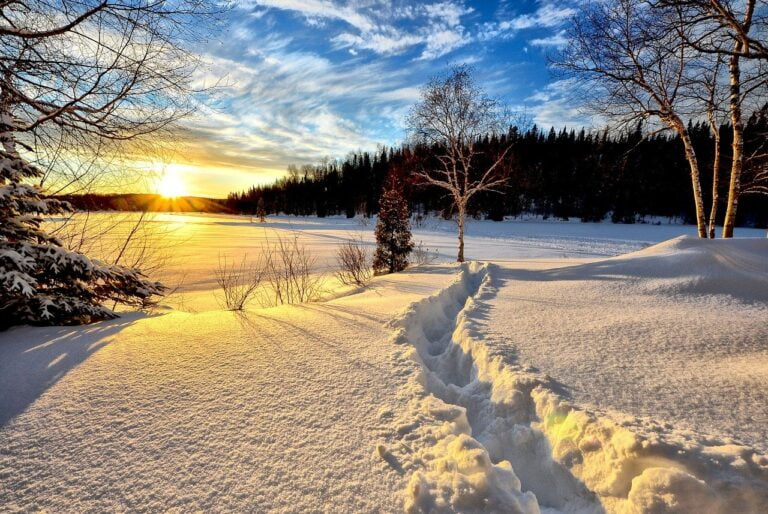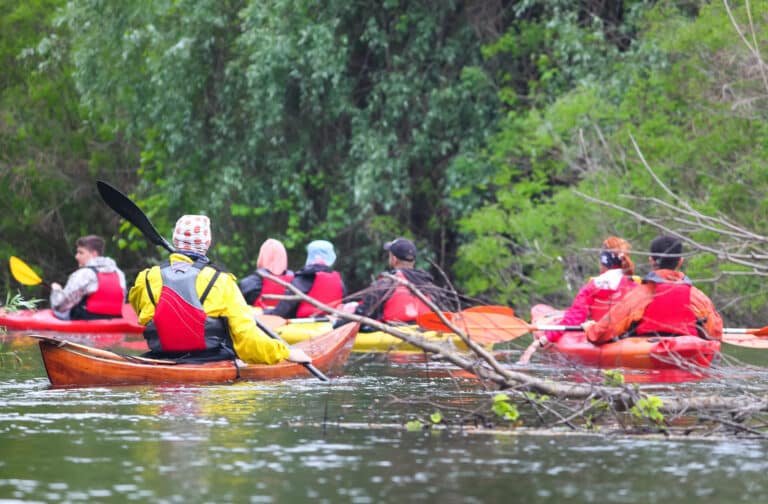Climate Impact On Ski Seasons: The Truth About 2024

Our content may include affiliate links, through which we earn a small commission on purchases. Want to learn more about us? Read here.
Climate change refers to significant changes in global temperatures and weather patterns. While climate change is a natural phenomenon, scientific evidence shows that human activities, particularly greenhouse gas emissions from burning fossil fuels, are now driving unprecedented changes.
These include rising global temps, melting polar ice caps, rising sea levels, and increased frequency and severity of extreme weather events. The impacts of climate change are global in scope and unprecedented in scale, threatening ecosystems, human health, economies, and the very fabric of societies around the world.
By altering the planet’s natural systems, climate change challenges the resilience of environments and the species that depend on them, including humans.
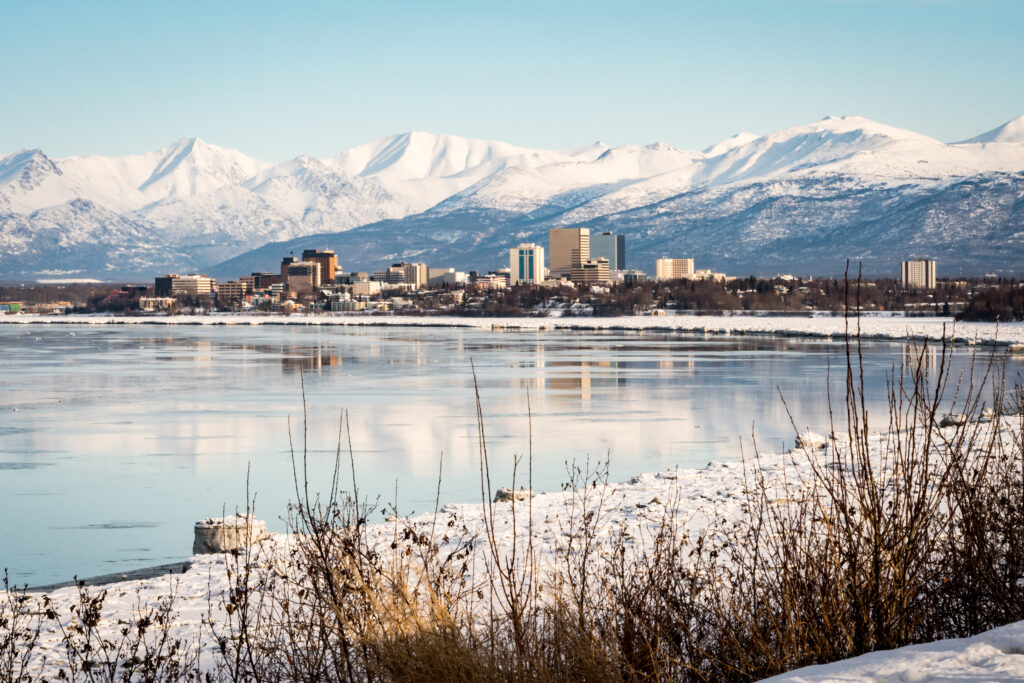
The ski industry is a significant economic and cultural force in many regions, providing employment and recreational opportunities and supporting local economies. It relies heavily on consistent, seasonally cold weather and adequate snowfall to create ideal conditions for skiing and snowboarding.
Climate change is making the ski industry more vulnerable due to shorter winters, unreliable snowfall, and warmer temperatures, diminishing the ski season. Resorts increasingly depend on costly snowmaking, impacting tourism and economic stability in winter-dependent areas. As these changes continue, the industry faces significant challenges in remaining viable and supporting its communities.
Overview of the 2024 Ski Season
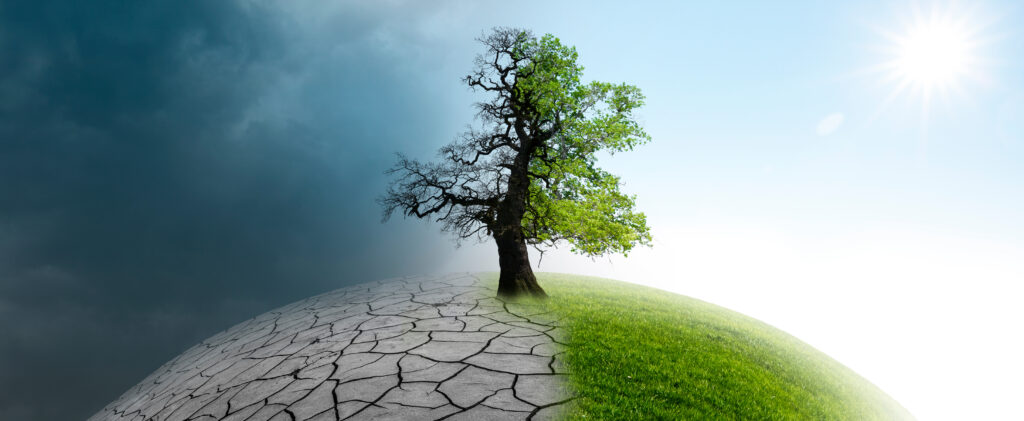
For the 2024 ski season, the overview across key regions like North America and Europe showed a mixed bag regarding snowfall levels and temperature trends. These fluctuations indicate the broader impacts of climate change on winter sports, with many areas reporting deviations from historical averages.
North America: The season started with below-average snowfall in many parts, including iconic ski destinations such as Tahoe and Vail. Tahoe, for instance, reported a total season snowfall of just 49 inches by January, significantly lower than usual.
Despite lower snow depths, some resorts offered reasonable piste skiing through extensive snowmaking and grooming efforts. However, the warmer temperatures posed challenges, affecting snow quality and longevity.
Europe: European ski resorts also faced challenges, with some areas reporting warmer than average temperatures leading to delayed season starts. The Alps, a prime ski destination, experienced variability in snowfall, with some regions enjoying ample snow while others were left wanting.
This inconsistency impacted the early season skiing conditions and forced many resorts to depend heavily on artificial snow.
Examples of Impacted Ski Resorts
Palisades Tahoe (USA): This resort exemplified the struggle with a significant shortfall in snowfall, managing only 49 inches of snow by January, showcasing the stark impact of warmer conditions on natural snow availability.
Vail (USA): Despite lower snow depths, Vail provided reasonable skiing conditions thanks to their snowmaking capabilities, highlighting the increasing reliance on artificial snow in warmer winters.
Mont Tremblant (Canada) and Lake Louise (Canada): These Canadian resorts experienced less snow but managed operations, underscoring the widespread nature of the issue across North America.
The variability in snow conditions across these key regions underscores the growing unpredictability and challenges the ski industry faces due to climate change. While snowmaking technologies have provided a stopgap, the broader implications of these trends pose significant questions about the future sustainability of snow-dependent winter sports.
Section 2: Climate Change and Its Direct Effects on Skiing
Climate change is significantly altering the landscape of winter sports, most notably skiing and snowboarding. The primary concern is the trend towards shorter winter seasons and the decreasing reliability of snowfall. Historically, ski resorts could depend on natural snowfall patterns to provide a base for the entire season.
However, as global temperatures rise, the window for cold enough conditions for snowfall is shrinking. This results in later snowfalls at the start of the season and earlier thaws at the end, effectively shortening the winter sports season.
Moreover, the snow that does fall is less reliable. Increased temperature volatility means precipitation is more likely to fall as rain rather than snow, particularly at lower altitudes or latitudes where marginal temperatures are becoming more common.
This reduces the number of skiable days and affects the quality of the snow, with freeze-thaw cycles leading to icier conditions and less powdery snow.
Research supports these observations, with studies indicating a trend towards warmer winters and reduced snowpack across many traditional skiing locations. For example, the Intergovernmental Panel on Climate Change (IPCC) has documented the ongoing rise in global temps and its impact on snow and ice-covered regions.
Specific studies on mountainous areas popular for skiing in Europe and North America have shown a consistent decrease in snow depth and duration over recent decades.
Experts in climatology and winter sports industries express concerns about the sustainability and economic impacts of these trends. According to the National Snow and Ice Data Center (NSIDC) and other climate research institutions, the snow season is shortening by several days each decade.
This impacts the ski season’s length and start and end times, making it more difficult for resorts to plan and maintain consistent operations.
Moreover, professionals within the industry, including resort operators and tourism boards, have acknowledged the need to adapt to these changing conditions. They report investing in snowmaking technology and diversifying resort offerings to include activities that do not rely on natural snow, indicating a shift in how the industry operates in response to climate change.
The cumulative evidence from scientific studies and expert opinions paints a clear picture: climate change is a pressing challenge for winter sports, necessitating significant adaptations to preserve these activities for future generations.
Section 3: Regional Impacts and Case Studies
Western US Ski Resorts: The ski resorts in the Western United States, including those in California, Colorado, and Utah, have experienced notable impacts from the climate crisis. For instance, resorts like Tahoe and Vail have seen seasons with below-average snowfall, leading to increased reliance on snowmaking.
Studies indicate that the snowpack in the Western US has decreased over the decades, with projections suggesting continued decline. This trend challenges the sustainability of ski resorts that depend heavily on natural snow.
Canadian Ski Resorts: Canadian resorts like Mont Tremblant and Lake Louise have also felt the effects of warmer winters. While Canada’s vast geographical range means variability in impact, the general trend towards warmer temperatures has reduced snowfall and shorter seasons in some areas.
Research focusing on the Canadian Rockies and other key skiing areas has documented these changes, highlighting concerns for the future of the winter sports industry in Canada.
Regions Defying Trends with Ample Snowfall
Japanese Ski Resorts: Contrary to the trend in North America and parts of Europe, some regions in Japan, particularly in Hokkaido and the Japanese Alps, have continued to receive heavy snowfall. These areas are renowned for their deep, powdery snow, attracting international skiers and snowboarders.
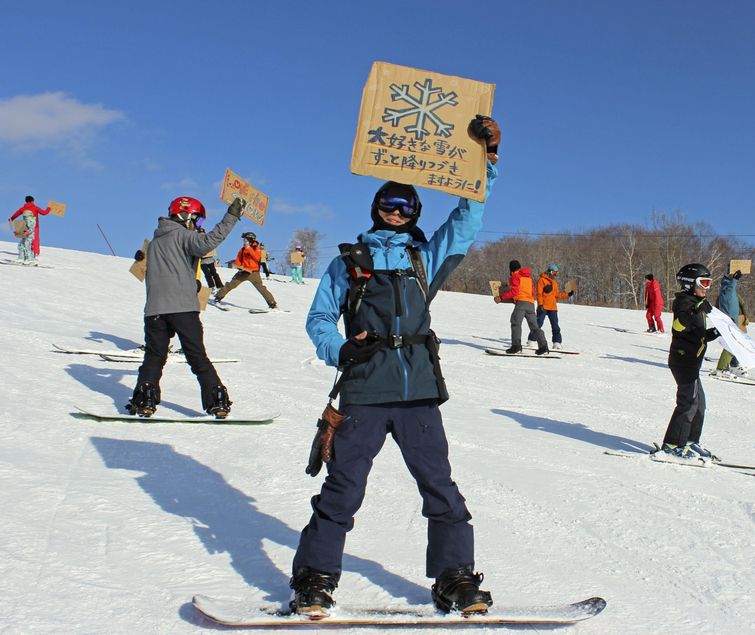
The consistent snow conditions in these regions can be attributed to their unique geographical and climatic factors, contrasting the challenges faced by ski resorts in other parts of the world.
Scandinavian Resorts: Some Scandinavian ski resorts have maintained relatively stable snow conditions. For example, Norway, Sweden, and Finland have benefited from their northern latitudes and colder climates, which have shielded them from the immediate impacts of climate warming.
These regions still experience ample snowfall, allowing for longer seasons compared to more temperate locations.
These case studies illustrate the varied impact of climate change on ski resorts worldwide. While many areas face challenges from reduced snowfall and warmer temperatures, others continue to enjoy abundant snow, providing a more optimistic outlook for the global ski industry.
However, the overall trend underscores the need for adaptation and sustainability efforts to mitigate the impacts of climate change on winter sports.
Section 4: Adaptations by Ski Resorts
Ski resort globally are increasingly adopting innovative strategies to adapt to the challenges posed by the climate crisis. One of the most widespread adaptations is the investment in snowmaking technology.
As natural snowfall becomes less reliable, resorts have turned to snow guns and cannons to ensure slopes remain operational throughout the season. This technology allows for snow production even in marginal temperatures, providing a more consistent base for skiing and snowboarding.
However, snowmaking is energy and water-intensive, prompting resorts to seek more efficient and sustainable methods.

Beyond snowmaking, resorts are diversifying their offerings to become year-round destinations. Activities such as mountain biking, hiking, zip-lining, and hosting events and festivals during the off-season help maintain revenue streams and reduce the economic dependence on winter sports.
This diversification helps stabilize the resorts’ financial health and caters to a broader audience, promoting outdoor recreation yearly.
In response to the environmental impact of their operations and the broader implications of climate change, many ski resorts are implementing sustainability measures. Efforts include investing in renewable energy sources, such as solar and wind power, to run lifts and other facilities to reduce the carbon footprint associated with resort operations.
Energy efficiency improvements, such as upgrading to LED lighting and optimizing snowmaking systems, further reduce energy consumption.
Water conservation is another critical area of focus, given the significant water requirements of snowmaking. Resorts are adopting innovative water management practices, including recycling water for snow production and carefully monitoring usage to mitigate the impact on local water resources.
Additionally, some resorts participate in reforestation and habitat restoration projects to offset carbon emissions and contribute to conserving the natural environment surrounding their operations. These initiatives, often in partnership with environmental organizations, underscore the ski industry’s growing commitment to sustainability and environmental stewardship.
Together, these adaptations and sustainability efforts reflect the ski industry’s proactive approach to navigating the challenges of climate change. By innovating and implementing environmentally responsible practices, resorts aim to ensure the long-term viability of winter sports while minimizing their ecological footprint.
Section 5: The Role of Skiers and the Community
Skiers and the broader community are crucial in supporting sustainability efforts within the ski industry. One significant way individuals can contribute is by practicing responsible skiing.
This includes respecting designated trails to prevent damage to surrounding ecosystems and minimizing waste by reducing single-use plastics and properly disposing trash. Carpooling or using public transportation to access ski resorts reduces travel-related carbon emissions.
Moreover, skiers can participate in environmental conservation programs and volunteer for reforestation and clean-up efforts, enhancing the natural habitats around ski areas. By being environmentally conscious and advocating for sustainable practices, the community can help preserve the winter sports environment for future generations.
Enthusiasts can support eco-friendly ski resorts and practices by choosing destinations that prioritize sustainability. This involves researching resorts’ environmental policies and initiatives, such as using renewable energy, water conservation measures, and commitment to reducing carbon footprints.
Many resorts now highlight their sustainability efforts on their websites, making it easier for consumers to make informed choices.
Patronizing these resorts sends a strong message about consumer values and the demand for responsible tourism. Additionally, skiers can engage in programs offered by resorts, such as carbon offset purchases, to compensate for the emissions associated with their travel to the ski area.
Purchasing gear from companies emphasizing sustainability in their manufacturing processes and materials selection is another way to support the industry’s green movement. Many brands now focus on eco-friendly production techniques, recycling programs, and durable products to reduce environmental impact.
By adopting these practices and supporting businesses that align with sustainability goals, skiers and the broader community can significantly contribute to preserving and protecting winter sports environments.
Encouraging a culture of responsibility and sustainability within the skiing community can lead to more meaningful and lasting changes in how ski resorts and individuals approach the challenges posed by climate change.
Section 6: Looking Ahead: The Future of Skiing
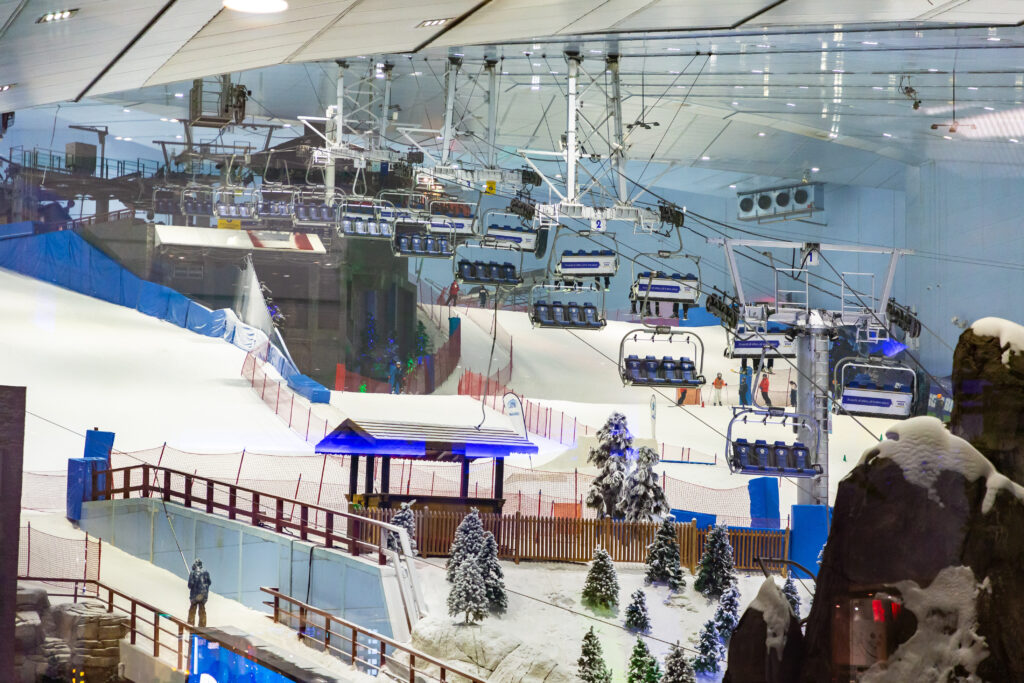
The future of skiing under the shadow of climate change can be envisioned through both pessimistic and optimistic scenarios.
Pessimistic Scenario: In a more pessimistic outlook, continued warming could significantly shorten the winter season, reducing natural snowfall and increasing snowmaking’s cost and environmental impact.
This could lead to the closure of lower-altitude and financially vulnerable resorts, reducing access to the sport and potentially leading to a decline in skiing popularity. Economic pressures could also increase prices, making skiing less accessible to the general public and impacting communities dependent on ski tourism.
Optimistic Scenario: On a more hopeful note, the ski industry’s proactive adaptations and technological advancements may mitigate some negative impacts. Investments in sustainable practices and community and industry-wide efforts to combat the climate crisis could lead to a resilient ski industry that offers winter sports experiences despite variable conditions. Increased awareness and action on climate issues could also lead to more significant global efforts to limit warming and preserve snowfall and skiing conditions.
Several innovations and technologies offer hope for sustaining skiing as a popular winter sport:
- Advanced Snowmaking: New snowmaking technologies that operate efficiently in a wider range of temperatures can help resorts maintain snow cover even during warmer winters. Innovations in energy-efficient snow guns and systems that recycle water significantly reduce the environmental footprint.
- Snow Farming: Some resorts are experimenting with snow farming, which involves storing and using snow from one season to supplement the next season’s base. This method ensures a consistent start to the ski season.
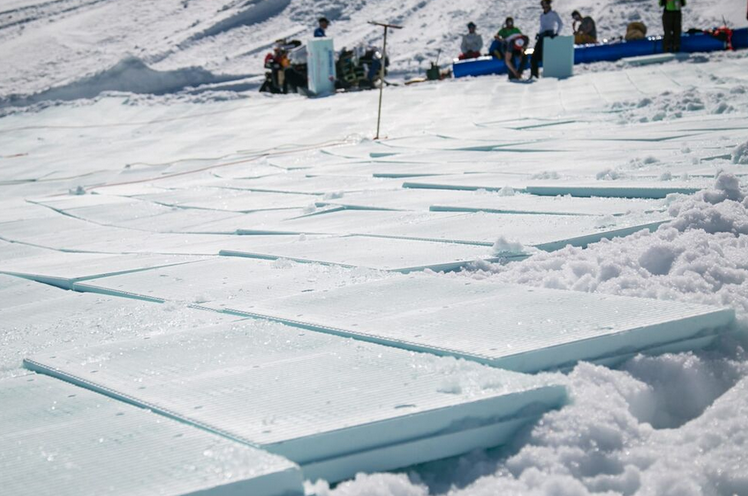
- Indoor Ski Slopes: While not a replacement for outdoor skiing, indoor ski slopes offer a controlled environment for skiing year-round, regardless of outdoor climate conditions. These facilities help maintain interest in skiing and serve as training grounds during off-seasons.
- Renewable Energy: Resorts are increasingly turning to renewable energy sources, such as solar and wind, to power operations. This reduces the carbon footprint of snowmaking and other resort operations, contributing to broader efforts to combat climate change.
- Material Science in Gear Manufacturing: Advances in material science are leading to more sustainable ski gear, with companies focusing on recycled materials, eco-friendly production processes, and longer-lasting products. This reduces the environmental impact of the gear lifecycle.
By embracing these and other innovations, the ski industry can adapt to and mitigate some effects of climate change, ensuring skiing remains a vibrant and accessible winter sport for future generations.
Conclusion
This exploration underscores the impact of climate change on skiing, emphasizing the need for adaptation and collective action. Climate change is reshaping winter sports, prompting the ski industry to innovate with new technologies and sustainable practices. The commitment of skiers and community commitment to eco-friendly practices is vital for preserving winter landscapes.
The future of skiing hinges on combating climate change through global actions and local initiatives. By adopting sustainable measures, supporting environmental conservation, and advocating for policy changes, we can help safeguard skiing and the planet.
The ski industry’s response to climate challenges highlights our ability to adapt and the importance of collective efforts to ensure the sport’s longevity and the health of our winter environments.

